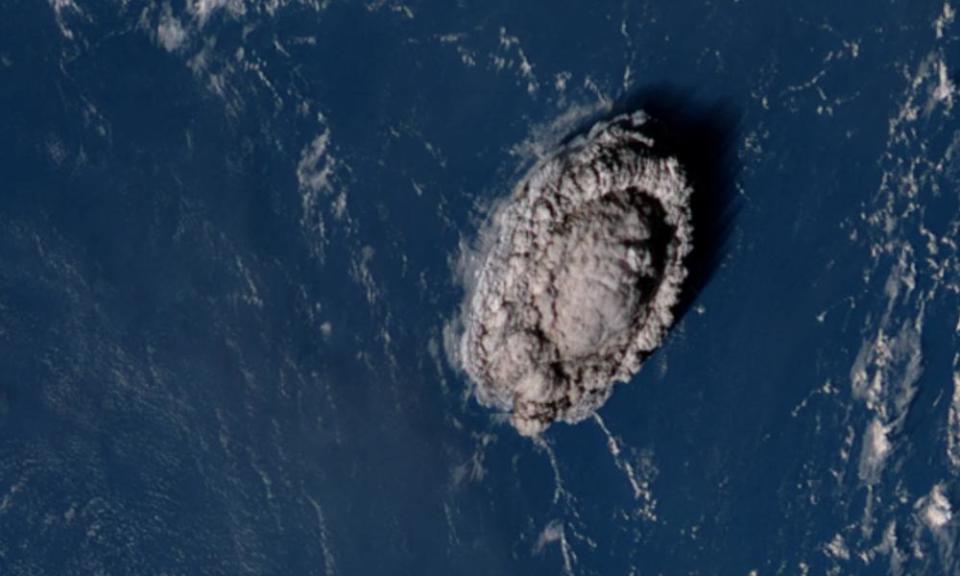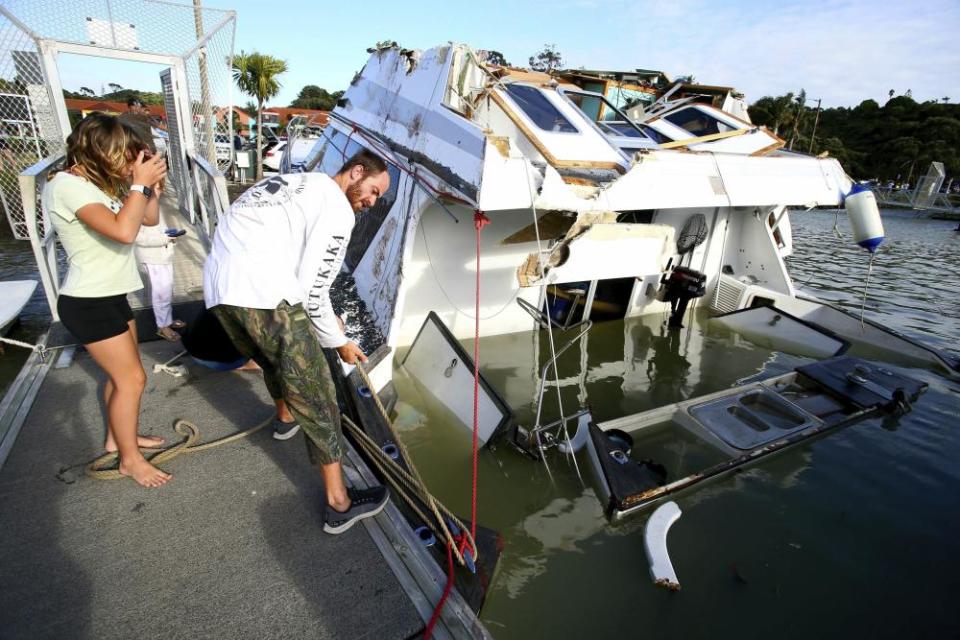Diary of a disaster: the week that Tonga went silent
It was the week Tonga disappeared.
Riveted by the shocking satellite images of the eruption of the Hunga Tonga-Hunga Ha’apai volcano and subsequent tsunami, the eyes of the world turned to the South Pacific island country, home to about 100,000 people, on Saturday. But just as the world was desperate for news from Tonga, it went dark.
Damage to the undersea cable that supplies Tonga’s internet and much of its communication infrastructure has meant the extent of the damage there, and the death toll, has, for many days, gone largely unknown.
Even the smallest slivers of information have been seized upon by the Tonga diaspora, desperate for news of their loved ones.
The Tongan government, when it was finally able to broadcast a statement to the world three days after the disaster, announced that Tonga had suffered an “unprecedented disaster”; that the waves from the tsunami reached 15m high on some islands, and that at least three people had died.
Almost one week on, much is still unknown. Calls to Tonga still do not connect, or if they do, drop out after just seconds. The internet is still almost impossible to access. And while some aid has finally landed, this is also not without its complications: with fears that aid workers could bring Covid-19 to a country that has recorded just a single case throughout the entire pandemic.
This is how Tonga’s week of disaster unfolded:

Saturday 15 January: ‘It was raining stones’
The air across Tonga smelled like sulphur, as it had done for weeks due to the active Hunga Tonga-Hunga Ha’apai volcano, which lies 65km from Tonga’s capital of Nuku’alofa.
At 5.10pm local time, four loud volcanic explosions rocked the country.
The blasts from the volcano could be heard in Fiji and Vanuatu, where people shared videos of their homes shaking for hours. It was also felt in New Zealand, more than 2,000km away.

The eruption prompted a tsunami. Later the government of Tonga would announce that on some islands, the waves were up to 15m high.
Branko Sugar and his son were spearfishing on an outer reef when the volcano erupted and tsunami waves came.
“We stopped the boat and just looked. Then we saw the wave coming towards us. The biggest wave I’ve ever seen,” Sugar told Reuters.
Sugar turned his boat, a 400-horsepower 27-foot (8 metre) World Cat catamaran, and accelerated toward deep water near Eueiki Island.
“That’s what saved us, the power of the boat,” he said. “I shouldn’t be alive.”
“The wave came past us and hit the main island, and then we knew we’d managed to get away. But then the rocks started raining. It was raining stones,” he recalled.
The sky turned to total darkness, as ash enveloped everything. Ash and rocks rained from the sky.
Iliesa Tora, a journalist based in the capital of Nuku’alofa, who contributes to the Guardian, did a Facebook Live from his car as he was stuck in a long line of traffic trying to get to higher ground in Nuku’alofa, the capital. He turned the camera to show the darkness and falling rocks outside his car.
“Pray for Tonga,” he said.
Sunday 16 January: ‘Nuku’alofa is covered in thick plumes of volcanic dust’
On Sunday, there was silence. Almost all communication was shut off, as it became clear that damage had been done to Tonga’s all-important undersea communications cable.
Jacinda Ardern, the prime minister of New Zealand, told a news conference that contact had not been established with coastal areas beyond the capital, Nuku’alofa. “Nuku’alofa is covered in thick plumes of volcanic dust but otherwise conditions are calm and stable,” Ardern said.
Meanwhile, the volcano was making itself felt around the world. Large waves and strong currents were recorded in many coastal areas globally. Two people drowned off a beach in the Lambayeque region of Peru, after unusually high waves were recorded there.
Monday 17 January: The first death
The ash cloud lifted across Tongatapu, the main island of Tonga, for the first time since Saturday and blue skies were seen again.
Dr Faka’iloatonga Taumoefolau, a project coordinator for the Tonga Parliament Buildings Project, tweeted a thread of images and videos on Thursday, when he was able to get a brief spot of internet. One video, taken on 17 January, showed the streets covered in ash. “I took this video because up until this point it was almost as if I had forgotten what a day was like with sunlight,” he wrote. “Heading to work for the first time after the calamity, had to help. You start to see more visibly the scale of the damage. Even the top of Mala’e Aloa [a cemetery in Nuku’alofa] wasn’t spared and fences – be it wood, plants, or brick cement – just brushed away like it was nothing.”
Tongans around the world waited desperately for news. It was confirmed the communications cable was broken in two places and it could be weeks before normal services resume.
“We’ve heard nothing at all,” said Seini Taumoepeau, a Tongan-Australian artist and activist based in Sydney. “I would say I’ve had four hours [of sleep each night] at the most.”
News emerged on Monday of the first death from the disaster – a 50-year-old British woman named Angela Glover.
Her brother described in an interview with the Guardian how Glover and her husband were swept away by the tsunami. Her husband was able to cling to a tree, but she was not. Her body was found late on Monday.
Tuesday 18 January: ‘An unprecedented disaster’
The first official update from the Tongan government was published.
The government called the incident an “unprecedented disaster” and confirmed three deaths: Briton Angela Glover, a 65-year-old woman from Mango island and 49-year-old man from Nomuka island, whose names have not been released.
The government expressed serious concerns about water supplies being affected by volcanic ash.
Meanwhile, aerial photographs were leaked from a surveillance mission undertaken by the New Zealand defence force. The images showed for the first time the scale of the damage across the islands, with some areas unaffected but for ash covering all surfaces, whereas other areas suffer from “catastrophic damage”. There were particular concerns for the remote islands of Mango, where all houses were destroyed, and Fonoifua, where just two houses remained.
But the images also showed people already at work cleaning the debris and ash. One image, taken of the south-eastern runway of the Fua’amotu International Airport, showed a group of people with shovels and wheelbarrows clearing the runway, to make it safe for planes to land.
Wednesday 19 January: Fears of a ‘tsunami of Covid’
The first aid shipments left for Tonga from New Zealand, amid fears that relief efforts could bring a “tsunami of Covid” to the Covid-free nation and more images begin to emerge of the damage.
Some contact was restored and Pacific social media filled with relieved tweets and posts from people who have finally been able to make contact with loved ones.
“I can finally get some good rest after hearing both my parents’ voices this evening,” tweeted Sera Lenora Lala.
Another person tweeted: “I missed a call because I thought it was a reporter but it was my dad,” with sobbing emojis. “He left a voicemail, thank God for that! Sitting here replaying it gives me so much comfort.”
Thursday 20 January: A miracle
The miraculous story of Lisala Folau emerged from Tonga.
Lisala Folau, a retired disabled carpenter, told Tongan radio station Broadcom FM that he swam and floated from his island of Atata via two other uninhabited islands to eventually reach the main island of Tongatapu, a total distance of around 13 kilometres.
Folau’s remarkable story, which included him hearing his son call to him from the shore after he had been swept into the night but deciding not to respond because he didn’t want his son to risk his life by coming in after him, and of seeing a police rescue boat and frantically waving at it, but it not seeing him, captured global attention.
People got out to the streets to assist with cleanup efforts: clearing roads of debris and ash. There were reports of people collecting the volcanic ash to use as fertiliser on their plantations, and also of people making it into speed humps on the road to encourage people to drive more slowly, so their cars would not spray ash onto people’s homes.
Friday 21 January: ‘Ofa atu’
As more power was restored around the country and satellite links were established, more images and video emerged, showing the scale of the destruction and the huge rebuilding effort ahead.
Roughly 20% of Tongans live below the poverty line, and the country’s GDP per capita sits at just above US$5,000. Much of the economy of the country is based on remittances, with Tongans overseas sending money back to the islands.
Families in the Tonga diaspora in Australia, New Zealand and the US were already raising funds for recovery efforts and preparing for rebuilding, which is expected to take years.
“Thanks for all the messages. Can’t get through them all. Limited network,” tweeted Ana Tupou Panuve, a senior economist with the National Reserve Bank of Tonga. “Country in recovery mode. ‘Ofa atu (love you).”

 Yahoo Movies
Yahoo Movies 
